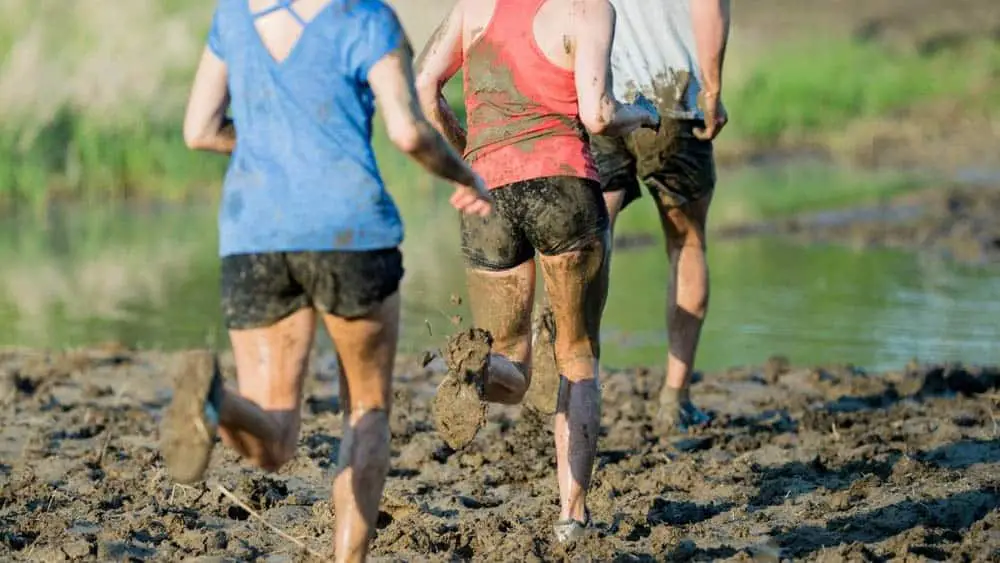
Hiking, and running along trails are somewhat therapeutic. It’s supposedly light and breezy. Just walk or run at your own pace. Take a whiff of fresh morning dew, the cold breeze on your face, but what happens when the path is covered with mud? How do you run the muddy trails?
As a trail runner myself this is what I do when I run in muddy trails: I wear my most aggressive trail shoes like Inov8 MudClaw. I run slower during sharp turns or downhills. I embrace it and expect to fall, so always be aware and ready to somersault.
If you are, however, hesitant of somersaulting your way through the trail, the good news is there are other ways of conquering muddy trails- maybe try rolling? Kidding aside, I’ll give you some tips and tricks for your new adventure. Including the things you should expect and prepare for, and maybe even a little recommendation on the best shoes to wear.
Mud trails and what to expect
Now let’s get down to business. There are two things you have to consider in mud trail running. First, to understand what trail running is, and then the additional environmental factor- the mud.
Essentially the point of trail running is to be off the road. Only then would you experience running that isn’t determined by the carved paths that you will often encounter as an occasional jogger in suburban parks or city parks. A word of precaution though, because again it’s foremost an off the road or trail experience, the path can be unpredictable.
Take, for example, taking the road less traveled, can mean that there might be crawling roots of trees, big as they may come, or big ‘ol trees that can be disorienting. The latter is quite possible especially if you’re not familiar with the trail.
As for the time of the run, it’s best to do it early in the morning. Not only is the sunrise an amazing view that you can never have too much of, but of course trail running is still an exercise. So, doing it to jump-start your day might just save you from having a lousy one.
Now, for the mud part. It adds to the need to take into consideration if you are prepared or fit for the activity. Mud trail running offers enjoyable experiences but could also present danger. A puddle is okay, but if the unpaved path is covered with slippery mud as you go uphill or downhill, it can and will cause problems.; hence there are gears created for this type of sport; which we will discuss later on.
Transitioning from road to trail
The striking difference between the two is the surface; hence, this entails a different type of preparation. Here’s a quick comparison between the two:
| Road running | Trail running |
| faster (speed workouts) | slow and steady wins the race |
| softer and gentler | rough and unpredictable surface |
| awareness is directed to traffic | awareness is directed to the terrain |
Now that you know whether you want to pursue the trails, especially when it gets muddy, there are other things you need to know. Just three things actually:
- Practice, practice, practice– Transitioning between the two might sound easy, but don’t underestimate the trails. Before you go on and conquer big heights, how about starting small first. Run up and down the hill, see what kind of pace works with you.
- Check out your shoes- If you haven’t heard yet, there are in fact differences in running shoes. Some are made for terrains, others, or not. It’s best to check which is which. You don’t necessarily have to buy new shoes, but yes, getting the right kind of shoes for trails, especially mud trails, will make your life easier.
- Buddy up- If you’re a beginner in these trails, and do decide to get rough and dirty the first time around, take a buddy with you. As I said, these trails are off-road, chances are there won’t be anyone with you as you do this task. If you get lost or need any help, it would be difficult to reach you. It’s always a good idea to have someone with you in the beginning.
Mud trail running checklist
First and foremost, you’d need a weather and time check. Let’s say it’s springtime, snowy one day and the next it’s shimmering, shining, splendid sunny. Then you’d know what to expect. Thawing ice, and muddy trails. As for the time, as we mentioned before, it’s best to start early. After all, the early bird catches the worm.
Now, instead of listing the obvious things needed like food, water, cash, and extra clothes, as I also previously explained, you’ll need certain mud gears. For mud trail running, it’s also good to wear a parka or a water-resistant jacket in case it rains.
Another thing to check on your list is a good pair of mud running shoes. You might want to check out The Run Testers youtube page, to see just what experts think you should wear as you tackle this trail. But for now, I made it easier for you and took notes on what he recommends. The list is arranged from lowest to highest price:
- SAUCONY PEREGRINE 10
- Price: $120
- Weight: 303 G/ 10.70 oz
BENEFITS
- All-around the trail shoes
- Geared towards the grass and muddy ground
- Lots of chevron for firm surfaces
- Durable and comfortable
* Chevron is a pattern or figure in the shape of a letter V or inverted V.
- HOKA ONE ONE EVO JAWZ
- Price: $130
- Weight: 204 g/ 7.2 oz (X)
BENEFITS
- Lightweight
- It’s a good option for less aggressive course or the rain have not ruined the ground
- Good for longer runs
- For general sloppy grounds
DOWNSIDE
- Not as good as finding grip on bad terrain
- Not made for quick-dry
- SALOMON SPEEDCROSS 5
- Price: $130
- Weight: 320g/ 11.3 oz
BENEFITS
- For muddy forests
- Pricey but you can find them in sales
- Chevron outsole for mixed terrain
- Good grip on mud
- Quick plot laces
- INOV-8 MUDCLAW G 260
- Price: $150
- Weight: 200 g/ 9.20 oz
BENEFITS
- Lightweight
- Graphene and rubber outsole; good for finding grip
- Durable (from pavements to muddy trails)
- Comfortable
- INOV-8 X TALON G 210
- Price: $160
- Weight: 210 g/ 7.5 oz
* The weight of the shoes is important because the lighter it is the
more comfortable and the smooth the in-shoe feel would be
BENEFITS
- Aggressive logs to power through muds
- The upper part of the shoes is thin and dries quickly
- Bottom part: graphene-enhanced rubber so it increases its durability
- Lightweight, easy to run with
Post-mud run clean up
Compared to running shoes, the mud trail shoes listed above, and those like it, are more resistant wear. So when it comes to cleaning them up, you won’t need it as often. Unless you do mud trail running regularly. Check out another youtube page, the Global Triathlon Network, for their tips and tricks:
THE DON’Ts
- Throw them in the washing machine to get rid of the chunky muds. Heat + spinning action = distorted soles and reduced life span of the shoes.
- Throw them in the tumble dryer to dry
- Put them in on top of the radiator to dry. Unless you want shoes that are hot and crispy.
THE DOs
- After the run, spray or hose down the shoes. To get rid of the rest of the mud, gently use a nail brush or old toothbrush.
- Untie your laces.
- Dry your shoes naturally.
- If you need to dry your shoes during the winter, try these steps:
- Get a newspaper or anything that could help soak up moisture.
- Remove the insoles of your shoes.
- Tightly wrap the insoles with the newspaper or your chosen material.
- With the remaining material, and scrunch them up into the balls to be used as stuffing for your shoes.
- Leave the shoes to dry in a warm place or under the radiator.
Takeaways
- Mud trails aside from the best getting down and dirty experience builds stamina and endurance.
- The type of shoes that you wear DO matter.
- When choosing the right pair, expensive doesn’t always mean it’s what you need. If you’re just starting out, it’s okay to buy the cheapest pair. Since you don’t even know if mud trail running is in your ballpark or to your liking. If it is, then good. That’s the only time investing in pricier options is a smart decision.
- The clean up is just as important as choosing the right type of shoes.
- Like any activity, it’s better to have someone with you as you start a new journey.
- It’s not road running OR trail running. You can always opt to choose both. You just need to be aware of the differences, so your body will be prepared for the terrain.
- The transition takes time. It’s not an overnight thing.
